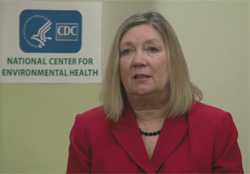Lead Poisoning Prevention Program
 Lead poisoning affects more than one million US children. Lead poisoning affects nearly every system in the body. It can cause learning disabilities and brain damage. Because it often occurs with no obvious symptoms, it frequently goes unrecognized. CDC’s Healthy Homes and Lead Poisoning Prevention Program is committed to the Healthy People goal of eliminating elevated blood lead levels in children as a major public health problem by 2020.
Lead poisoning affects more than one million US children. Lead poisoning affects nearly every system in the body. It can cause learning disabilities and brain damage. Because it often occurs with no obvious symptoms, it frequently goes unrecognized. CDC’s Healthy Homes and Lead Poisoning Prevention Program is committed to the Healthy People goal of eliminating elevated blood lead levels in children as a major public health problem by 2020.
Dr. Mary Jean Brown, Chief of the CDC’s Healthy Homes and Lead Poisoning Prevention Branch, is a leader and innovator in the field of childhood lead poisoning prevention.
Dr. Brown, what attracted you to the field of lead poisoning prevention?
I have been a nurse for 35 years and was drawn to lead poisoning prevention because it allowed me to address the very real consequences of lead exposure, which can limit a child’s academic ability and overall life success. As a nurse, this was very important to me, and remains so now that I’m a parent and grandparent.
CDC began to fund state programs to eliminate childhood lead poisoning in the United States around 1988. What were things like before the creation of these programs?
Just 25 years ago, lead was a much bigger threat than it is now. In 1977, more than half of the children in the US had very high blood lead levels by today’s standards. Lead was in our gasoline and our paint. It was really spread throughout the environment with great potential for harm to our children.
The Lead Contamination Control Act of 1988 had a tremendous impact on public health because it allowed for the creation of state childhood lead poisoning elimination programs. Before the Lead Control Act, most states had no such programs, and a lack of resources limited the effectiveness of the ones that did exist. There was no enforcement or regulatory authority.
When we learned that lead-based paint was a health hazard, people began to take steps to remove it from their home. However, the lead paint removal methods that people were then using often made the situation worse by spreading fine lead dust throughout the house. Children’s blood lead levels often increased dramatically as a result of renovation work that was intended to help them.
Perhaps most importantly, because leaded gasoline was commonly used in the years before 1988, lead was everywhere throughout the environment. As a result, children had blood lead levels that were much higher that what we see today, even among children not exposed to lead paint. To put that in perspective for you, in 1977, more than half of the children in the US had very high blood lead levels by today’s standards.
In other words, the field of lead poisoning prevention has come a long way in the past 20 years?
We’ve come a very long way. Between 1991 and 2006, the percent of US children 1 to 5 years old with elevated blood lead levels fell from 4.4% to 0.59%.We can attribute this remarkable public health success to many of CDC’s efforts, such as using blood lead testing data to identify places where children are most likely to be exposed to dangerous levels of lead, developing safe renovation guidelines, and educating parents.
Just as we have eliminated polio, smallpox, and tuberculosis as public health threats, CDC is on its way to achieving the ambitious goal of eliminating elevated blood lead levels in the U.S. This will make childhood lead poisoning the first environmental health disease to be eradicated.
What are the most important things parents should know about preventing childhood lead poisoning?
I can’t stress enough the importance of preventing lead exposure before it occurs. There are many simple steps you can take to make your home more lead-safe, for example:
- Talk to your local health department about testing paint and dust in your home for lead if you live in a home built before 1978.
- If you see paint chips or dust in windowsills or on floors because of peeling paint, clean these areas regularly with a wet mop.
- Wipe your feet on mats before entering the home. Also, removing your shoes when you entering the home is a good practice to control lead.
- Remove recalled toys and toy jewelry from children. Stay up-to-date on current recalls by visiting the Consumer Product Safety Commission’s Web site.
To learn more about lead and lead poisoning, please visit www.cdc.gov/lead.
Podcasts:
Get the Lead Out
Is Your Child Safe from Lead Poisoning?
New CDC Lead and Pregnancy Recommendation Report (2010)
- Page last reviewed: April 4, 2011
- Page last updated: April 4, 2011
- Content source:


 ShareCompartir
ShareCompartir